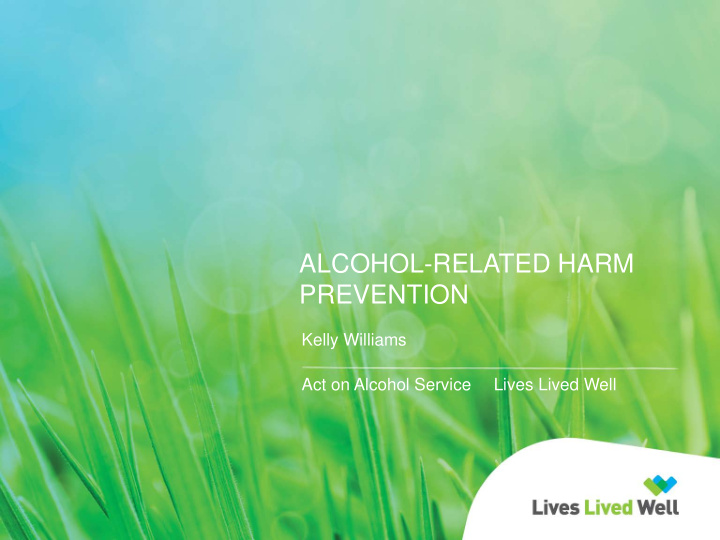



ALCOHOL-RELATED HARM PREVENTION Kelly Williams Act on Alcohol Service Lives Lived Well
Current trends for Australia Data from the National Drug Strategy Household Survey 2013 6.5% of Australians aged 14yrs + drank on a daily basis o Almost 1 in 5 people aged 14yrs + consumed more than two standard drinks per o day on average 1 in 3 people yearly and 1 in 4 people monthly had consumed alcohol at a level o placing them at risk of injury 1 in 5 recent drinkers put themselves or someone else at risk of harm while o under the influence of alcohol Around 1 in 6 people aged 12yrs + had consumed 11 or more standard drinks on o a single drinking occasion in the past 12 months
Risk of harm and alcohol To put this in context, current NHMRC Guidelines recommend:- No more than 2 standard drinks on any day to reduce lifetime risk of harm from o alcohol-related disease or injury; No more than 4 standard drinks on a single occasion to reduce risk of alcohol o related injury from each occasion The revised Australian guidelines to reduce health risks from drinking alcohol (2009) provide information for Australians on reducing risks to health from drinking alcohol, however.. There is no level of drinking alcohol that can be guaranteed to be completely ‘safe’ or ‘no risk’.
Alcohol-related harm • Whilst alcohol taxation generated approximately $7 billion for the Australian government in 2010, it was estimated that the financial cost of alcohol misuse is in excess of $14 billion per year • Health impacts – acute and chronic effects, Disability Affected Life Years (DALYs), burden of disease and injury • Social impacts – harm to family, friends, colleagues, community • Health inequalities – greater impact for Aboriginal and Torres Strait Islander peoples, those living in regional and rural areas
Policy context – National, State and Local • National Drug Strategy 2010-2015 (overseen by Ministerial Council on Drug Strategy) • Utilises a harm minimisation approach - demand, supply and harm reduction – focused on building safe and healthy communities • At state level, key alcohol policy responsibilities include law enforcement, licensing regulation, treatment services and drug education in schools • Local governments contribute to management of physical availability of alcohol and creating safer drinking environments
Evidence-informed practice • Prevention paradox – the ideology that more (net) harm may be prevented through universal interventions, rather than through strategies that only target the small proportion of high-risk users • World Health Organisation’s international review of alcohol-related research and public policy • More reviews and greater evidence of effectiveness for interventions such as Regulating physical availability Taxation and pricing Drink driving countermeasures Treatment and early intervention
Evidence-informed practice – continued • Less evidence of effectiveness for Altering the drinking context Regulating promotion Education and persuasion (school-based, mass-media, National drinking guidelines) • Integrated approach with a combination of strategies known to be effective is the best approach, with a focus on quality rather than quantity • The success of all evidence-informed practice hinges on proper engagement with and support from community, with local level action
Act on Alcohol Service • Funded by Queensland level action and response Department of Health until June 2017 • Service provided online through web portal and by • Survey on community phone to support individuals perception and attitudes to and communities alcohol-related harm and inform service provision • To be officially launched week commencing 2 nd November • A focus on primary prevention 2015 and building the capacity of communities to provide local-
Thank you for your interest! Questions ?
Recommend
More recommend